| thumbnail | comments |
|---|
| overall structure of the ship |
|---|
 |
Long-range view of the starboard side of the ship,
and slightly above the mid-plane.
The outline of the regular rectangular base of the display
has the potential to be used as an effective reference structure for stereoscoping photogrammetry.
|
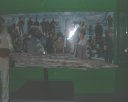 |
A direct view of the starboard side,
showing the ship's profile almost without interruption.
The original image was dominated by the flash reflection;
this version was made lighter
in order to make the ship visible.
|
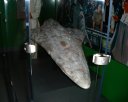 |
A long-range view of the whole ship
from just off the starboard side of the bow.
One wide, high aperature is visible on the bow;
it may be a hangar for fighters and smaller craft.
|
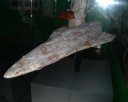 |
View of the whole ship,
from the port side of the bow.
One wide and tall groove on the port side of the bow may be a small fighter hangar,
but it is not large enough to accommodate a freighter or shuttle.
Other grooves seen further back on the port side may be gunports
containing turbolaser and ion cannons.
|
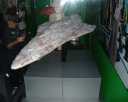 |
Another long-range view of the whole ship
from just off the port side of the bow.
|
| dorsal surfaces |
|---|
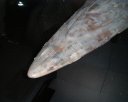 |
Closer image of the upper port side of the bow.
In this view we can see deeply into what is possibly a portside hangar
for small fightercraft and ships of a similar size.
|
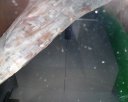 |
Close view of the ship's port side,
viewed from above the midplane.
|
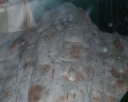 |
Detail of the middle of the dorsal surface.
There is an intriguing variety of components outside the hull;
perhaps these systems were added as upgrades
and were not part of the original design by the Mon Calamari.
|
 |
Fine detail on the dorsal surface,
including a dark, feathery and intriguingly regular structure.
Other images hint that there may be gun barrels among these pieces.
|
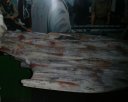 |
Dorsal surfaces of the starboard wing.
There are at least two long structures pointing aft,
which may be antennae of some kind,
or more likely the barrels of long cannons
that are unusually mounted on the exterior rather than the gunport grooves.
|
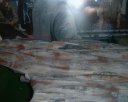 |
Dorsal surfaces of the middle and rear-middle of the ship.
A variety of thin external structures are visible,
and some of them look as if they may be cannons.
|
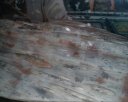 |
A closer view of dorsal surfaces on the starboard side,
but taken from further forward
and facing back towards a point between the starboard wing and the middle of the ship.
|
| thrusters and stern |
|---|
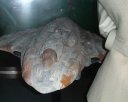 |
View of the tail from above.
It is interesting to note the lip on
the aft end of the largest super-blister on the middle of the dorsal surface.
The gap below the lip is filled with dark-coloured blisters of a smaller scale.
Is this some kind of critical hardware that needs special shelter?
Is it associated with the propulsion systems
or is there some other reason why it should face aft?
|
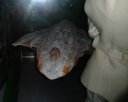 |
A more distanct view of the dorsal surfaces of the tail and the wings.
The cavity encompassing the thrusters extends outwards to the trailing edges of the wings.
These gaps are larger than the grooves on the bow.
If they are hangars they might be big enough to carry starfighters
with less of an awkward and dangerous squeeze.
|
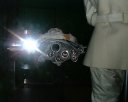 |
A nearly direct view into the engine cylinders.
|
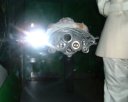 |
A nearly direct view into the engine cylinders.
|
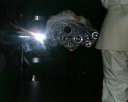 |
A view of the engine clusters
from an angle slightly further off to the starboard side.
|
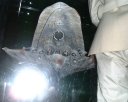 |
The fantail and thrusters as seen from behind and below.
The cavities on the inside trailing edges of the wings are clearly visible.
The dark inner shell of the fantail is interesting for its exposed gadgetry,
and for the fact that it does not encompass all of the thruster cylinders.
|
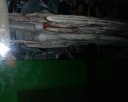 |
Thruster structures and the side of one wing,
viewed directly from the starboard side.
|
| ventral surfaces |
|---|
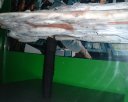 |
View from below the mid-plan, off the starboard side of the bow,
facing back towards the centre of the ship and the starboard wing.
Noteworthy features include:
(*) one long gun-port on a long ventral blister under the wing;
(*) and an apparent cluster of three or more heavy cannon barrels
bristling away from a point on the dorsal hull.
One structure visible on the upper side of the front of the wing
may be a miniature control pod,
which may perhaps be big enough for a few crewmen in cramped conditions.
|
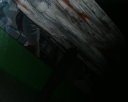 |
View towards the middle of the ship
(near the model's mounting point)
from a camera position below the mid-plane and off the starboard wing.
One of the thruster cylinders is visible
near the upper-left corner of the image.
|
| thumbnail | comments |
|---|
| length and situation |
|---|
 |
The Liberty in its display,
as seen from starboard bow.
The regular corners of the display base and transparent panels
might one day provide a conveniently orthogonal Cartesian reference
for stereographic interpretation.
|
 |
The Liberty in its display,
as seen from rear starboard.
One portal near the front of the starboard wing
is shaded and highly visible in this view.
There is another portal on the bow.
|
| bow |
|---|
 |
Bow of the Liberty,
sighting almost parallel to the long axis of the ship.
Two vaguely rectangular indentations occur on the starboard side
between the bow and the wing.
At least one more occurs on the port side.
There is no bilateral symmetry to this notches.
Are the notches sites of heavy turrets?
|
 |
Another view towards the bow,
but from a vantage closer to the midplane of the ship.
|
 |
The bow of Liberty,
as seen from somewhere ahead and below.
|
 |
A high view down towards the bow
and dorsal surfaces.
Most of the important dorsal blisters
and outgrowths of greeblies are at least vaguely visible.
|
| dorsal surfaces |
|---|
 |
Detailed view of the dorsal starboard surface.
Many fine antennae, and possibly some cannons,
are visible.
There isn't any obvious bridge pod,
although there may be something resembling a remnant of a bridge pod
near the right edge of the image.
|
 |
A sharp image of rear dorsal surfaces and some of the thrusters.
There is a scruffy, finely detailed area in a depression
near the middle of the ship.
A more bulbous collection of fine structure appears further forward:
the only (vaguely approximate) candidate for a bridge pod.
|
 |
A higher view of the starboard dorsal surfaces.
The two most finely detailed (greeblie) areas are visible on the midline.
The enclosure in the “armpit” of the starboard wing
is also apparent.
|
 |
A very high starboard dorsal view.
Most of the fantail, wing and middle areas are well resolved.
The bow is less well illuminated.
|
| thrusters and stern |
|---|
 |
A rear view of thrusters and underside of the fantail.
The upper central thruster can be removed from the model
when filming requires rear mounting.
There is a cavity in the “armpit”
of the starboard wing.
During the Battle of Endor this space (and its opposite on the port side)
were illuminated;
they may be hangars.
|
 |
View towards the thrusters and stern,
from a lower viewpoint.
The layout of rusty panels on the ventral surfaces
is apparent in this perspective.
|
 |
Side view of the engine cavity
and both layers of the fantail.
The small aperture at the base of the starboard wing
is clearly visible.
It is noteworthy that the thrusters are a nearly uniform grey colour,
in contrast to the mottled hull armour.
This implies that the colour variation on the hull may be decorative,
but neither advantageous nor desirable in the critical functional area of the engines.
|
| ventral surfaces |
|---|
 |
Underneath the starboard wing.
The model is mounted on a post that enters a flat, metallic, ovoid surface.
When the model is alternatively mounted from behind,
this surface would be covered with a detailed patch of hull.
The ovoid ventral hangar appearing in the movie may be somewhere foreward
(right in this photo).
|
 |
View towards the rear of the vessel,
from somewhere under and ahead of the starboard wing.
|
 |
Details around the model's support pillar.
Note how some of the rusty-coloured paint has permeated
some way onto the otherwise plain metallic surface of the mount.
This may indicate something about the way the (removed) blister was painted.
|
 |
A ventral view across towards the shoulder of the portside wing.
(The background is a reproduction of a painting of the rebel briefing scene.)
|
 |
Unidentified, possibly ventral surface.
|
 |
Unidentified, possibly ventral surface.
|
 |
Under the shoulder of the starboard wing.
|
 |
Extensive view of the forward ventral surfaces,
unfortunately partly obscured by foregraound reflection.
Nonetheless the basic layout of red areas and blisters is discernable,
as is the ovoid ventral cavity (slightly starboard and forward of the mounting pylon).
|